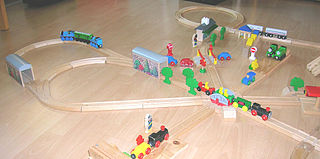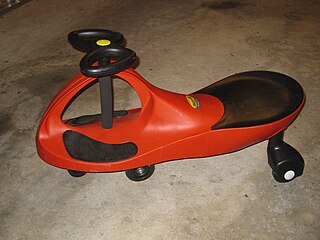i-Gami is a toy in which small plastic pieces can be bent and snapped together to form small to large three-dimensional figures. It began production in 2006 by Plastic Play Inc. before being acquired by PlaSmart Inc.
i-Gami is a toy in which small plastic pieces can be bent and snapped together to form small to large three-dimensional figures. It began production in 2006 by Plastic Play Inc. before being acquired by PlaSmart Inc.
i-Gami is a toy product created by Boaz Axelrad, a Canadian. [1] The toy takes inspiration from Japanese origami. Unlike origami, however, i-Gami is made from small pieces of plastic that can be bent and snapped together to form various figures, either in two- or three-dimensional form. Additionally, pieces can be disassembled and/or reused. Figures can be built either by following an instruction booklet which comes with each set, or by creating custom designs imagined by the creator.
i-Gami began production in 2006 by Plastic Play Inc., a company located in Oshawa before being acquired by Ottawa-based PlaSmart (best known for its success with the PlasmaCar) in 2009. [2] PlaSmart had previously been the exclusive US distributor of the product since 2007. The company now owns all intellectual property rights to and manufacturing assets for the product line. [2]
Currently, i-Gami is sold in box sets, ranging from beginner (54 pieces) to advanced (600 pieces).
i-Gami has been generally well received by consumers. [3] Consumers appreciate the fact that i-Gami promotes spatial learning, and also introduces the concept of counter pressure to young children. [3] It has received multiple awards (see Awards section) since its entrance into the market.

Origami is the Japanese art of paper folding. In modern usage, the word "origami" is often used as an inclusive term for all folding practices, regardless of their culture of origin. The goal is to transform a flat square sheet of paper into a finished sculpture through folding and sculpting techniques. Modern origami practitioners generally discourage the use of cuts, glue, or markings on the paper. Origami folders often use the Japanese word kirigami to refer to designs which use cuts.
An action figure is a poseable character model figure made most commonly of plastic, and often based upon characters from a film, comic book, military, video game or television program; fictional or historical. These figures are usually marketed toward boys and adult collectors. The term was coined by Hasbro in 1964 to market G.I. Joe to boys.

A thermoplastic, or thermosoftening plastic, is any plastic polymer material that becomes pliable or moldable at a certain elevated temperature and solidifies upon cooling.

Acrylonitrile butadiene styrene (ABS) (chemical formula (C8H8)x·(C4H6)y·(C3H3N)z ) is a common thermoplastic polymer. Its glass transition temperature is approximately 105 °C (221 °F). ABS is amorphous and therefore has no true melting point.

Airfix is a British brand and former manufacturing company which produced injection-moulded plastic scale model kits. In the UK, the name 'Airfix' has become practically synonymous with plastic models of this type, often simply referred to as "an airfix kit" even if made by another manufacturer.

Injection moulding is a manufacturing process for producing parts by injecting molten material into a mould, or mold. Injection moulding can be performed with a host of materials mainly including metals, glasses, elastomers, confections, and most commonly thermoplastic and thermosetting polymers. Material for the part is fed into a heated barrel, mixed, and injected into a mould cavity, where it cools and hardens to the configuration of the cavity. After a product is designed, usually by an industrial designer or an engineer, moulds are made by a mould-maker from metal, usually either steel or aluminium, and precision-machined to form the features of the desired part. Injection moulding is widely used for manufacturing a variety of parts, from the smallest components to entire body panels of cars. Advances in 3D printing technology, using photopolymers that do not melt during the injection moulding of some lower-temperature thermoplastics, can be used for some simple injection moulds.
Brio is a wooden toy company founded in Sweden. The company was founded in the small town of Boalt, Scania, Götaland in 1884 by basket maker Ivar Bengtsson. For a long time the company was based in Osby, Scania, in southern Sweden. In 1908 Ivar's three sons took the company over and gave it the name "BRIO", which is an acronym for: BRöderna Ivarsson (in) Osby. In 2006 BRIO moved its headquarters to Malmö, Scania. It is best known for its wooden toy trains, sold in Europe since 1958.

The Easy-Bake Oven is a working toy oven introduced in 1963 by Kenner and currently manufactured by Hasbro. The original toy used a pair of ordinary incandescent light bulbs as a heat source; current versions use a true heating element. Kenner sold 500,000 Easy-Bake Ovens in the first year of production. By 1997, more than 16 million Easy-Bake Ovens had been sold.

Magnetix is a magnetic construction toy that combines plastic building pieces containing embedded neodymium magnets, and steel bearing balls that can be connected to form geometric shapes and structures. Designed to be a cheaper version of the Geomag magnetic construction set, Magnetix's image suffered severely when an early manufacturing defect caused a death. It was sold under various brands after the defect was corrected.

Art toys, also called designer toys, are toys and collectibles created by artists and designers that are either self-produced or made by small, independent toy companies, typically in very limited editions. Artists use a variety of materials, such as ABS plastic, vinyl, wood, metal, latex, plush, and resin. Creators often have backgrounds in graphic design, illustration, or fine art, but many accomplished toy artists are self-taught. The first art toys appeared in the 1990s in Hong Kong and Japan. By the early 2000s, the majority of art toys were based upon characters created by popular Lowbrow artists, linking the two movements.
Dragon Models Limited is a Hong-Kong-based manufacturer of plastic model kits, diecast models and military action figures. Founded in 1987, the company shares distribution agreements with Stevens International in the United States, Revell/Monogram, Revell Germany and Italeri in Europe, and Hasegawa and GSI in Japan.

Wooden toy trains are toy trains that run on a wooden track system with grooves to guide the wheels of the rolling stock. While the trains, tracks and scenery accessories are made mainly of wood, the engines and cars connect to each other using metal hooks or small magnets, and some use plastic wheels mounted on metal axles. Some trains are made to resemble anthropomorphical, fictional, and prototypical railroad equipment.

Fisher-Price is an American company that produces educational toys for infants, toddlers and preschoolers, headquartered in East Aurora, New York. The company was founded in 1930 during the Great Depression by Herman Fisher, Irving Price, Helen Schelle, and Margaret Evans Price.
Zoomorphs is a line of educational building toys made by River Dolphin Toys, a Brooklyn-based company. Each set of Zoomorphs contains between 30 and 100 plastic animal pieces that can be snapped together to form actual creatures, such as a cat or dinosaur, or rearranged to create fantasy creatures, such as a dino-cat-horse-bird. Each set's pieces are interchangeable with the pieces of all the other sets. As of late 2006, Zoomorphs were available in nearly 1,100 specialty toy stores.

Disposable food packaging comprises disposable products often found in fast-food restaurants, take-out restaurants and catering establishments. Typical products are foam food containers, plates, bowls, cups, utensils, doilies and tray papers. These products can be made from a number of materials including plastics, paper, bioresins, wood and bamboo.

The PlasmaCar is a plastic ride-on toy car designed for children, made popular by Canadian toy distributor PlaSmart. The PlasmaCar can be propelled by wiggling the front steering wheel which is attached to two pivoting wheels touching the ground. It harnesses the natural forces of inertia, centrifugal force, gravity, and friction in order to drive the car forward and backward. It does not require a power source such as batteries, fuel, pedals, or gears - it simply runs on the child's ability to wiggle the steering wheel. It can be operated indoors and/or outdoors, though it works best on a smooth, flat surface.
PlaSmart is a Canadian-based, global toy distributor located in Ottawa, Ontario that specializes in toys and games that develop motor skills, hand-eye coordination, problem-solving, and creative play. Formed in 2003 by Canadian entrepreneur Timothy Kimber, PlaSmart launched its first product, the PlasmaCar, to the North American market. The company has since grown to 14 employees and over 90 sales contractors, with products available worldwide in more than 60 countries.
Paper toys are constructed in several ways, by folding, as in paper airplanes, paper fortune tellers or Origami, or by cutting, decorating or assembling pieces of paper with glue or tape to create a paper doll or paper model.

Éric Joisel was a French origami artist who specialized in the wet-folding method, creating figurative art sculptures using sheets of paper and water, without the use of any adhesive or scissors.
Prizes are promotional items—small toys, games, trading cards, collectables, and other small items of nominal value—found in packages of brand-name retail products that are included in the price of the product with the intent to boost sales, similar to toys in kid's meals. Collectable prizes produced in series are used extensively—as a loyalty marketing program—in food, drink, and other retail products to increase sales through repeat purchases from collectors. Prizes have been distributed through bread, candy, cereal, cheese, chips, crackers, laundry detergent, margarine, popcorn, and soft drinks. The types of prizes have included comics, fortunes, jokes, key rings, magic tricks, models, pin-back buttons, plastic mini-spoons, puzzles, riddles, stickers, temporary tattoos, tazos, trade cards, trading cards, and small toys. Prizes are sometimes referred to as "in-pack" premiums, although historically the word "premium" has been used to denote an item that is not packaged with the product and requires a proof of purchase and/or a small additional payment to cover shipping and/or handling charges.